 |
||
|
||
| ||
[ Read also: i845 based boards tested in September 2001 ] The situation with the i845 based boards looks funny. In November last year the revolutionary Pentium4 processor from Intel opened a new way of developing of the whole IT industry. It was so radical that only three major companies whose business was built on Intel's boards meant for Intel's processors agreed to participate in there. But even they - ASUS, Gigabyte and MSI - understood that the chipset's price and a 6-layer design made impossible to reduce prices for boards lower than $150, and the RDRAM support would make the boards affordable only for the riches and enthusiasts. The cardinal measures of Intel who offered processors together with the memory at a reduced price didn't help. Another problem was that the Socket-423 was planned only for a maximum of a year until the Socket-478, the right one for the P4, changed it. Besides, the first processor versions couldn't operate at their full potential due to a shortage of a clock speed and lack of the software supporting SSE2 and accepting the hyper-pipeline architecture. But the financial, technological, production and marketing resources of Intel made the whole industry move towards the its aim. By the way, a company which has invested billions so that its processors sell at high prices will never be able to sell them cheap. Though it can be discussed and disputed over and over again, this concept works. Mercedes, for example, is close to the exclusive cars in the price, but you know quite well that the sales volumes of these automobiles are not smaller than those of 5 times cheaper cars. Today it is clear that the triumphant procession of the Pentium4 is reality. But at the beginning of the year the turnovers concerning the i850 based boards made all the companies disappointed. It is only the major OEM customers who helped them not to lose the hope. Some time ago the situation became better: sales were growing, and prices for RDRAM and Pentium4 processors were decreasing. The chipsets became cheaper as well, but the high demand allowed the manufacturers to leave the prices for boards without any changes. In April the board makers who didn't deal in production of boards for Pentium4 almost turned towards this processor, but Socket-423 had not much time left to live. Some companies such as Elitegroup, ABIT and EPOX had some buildups for i850 boards and they put them into production in order to get a promising income. Some time later all others realized what they had lost... And Intel, at this sharp moment, started distributing samples of its new chipset for the Pentium4 with SDRAM support which was later announced as i845. And it worked! All manufacturers started developing boards on the new chipset trying to cover all market niches. The most ridiculous thing is that we have never seen before such a huge number of boards on one chipset! In such a situation Intel doesn't need another player on the chipsets market - variations of i845 and i850 boards meets all current market requirements. That is why the lawsuit against VIA is a part of a grant plan - i845 boards together with processors are selling with the help of not only Intel but the whole world, and there is no place for such mighty player as VIA. On the contrary, SIS and Ali do not have much power, and, therefore, they are allowed to play on this market. As a result, we have received 12 new i845 based boards. And when the P4X grow stronger, Intel will have another trump - the i845-D with DDR memory support. And today let's examine the boards on the i845... [ Summary table of all participating boards] Acorp 4S845A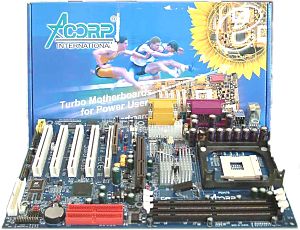 The board is known, first of all, for its inexpensive products. The company was founded in 1994, is located in Taiwan, and the name stands for A-class, Competitive, Organized, Reliable and Professional. This time the company decided to leave the image of a company developing cheap solutions. But the price for the today's board is not going to be too high. It is interesting that the PCB is blue and IDE connectors are red - the board reminds me that of Gigabyte. But you will definitely notice that the external connector (here it is COM2e) is yellow which is typical of Acorp. The board we tested is a pre-production sample, that is why there are not many accessories (it is only a user's manual and a CD-R with drivers). The production samples will be supplied with ATA66/100and FDD cables, a bracket with 2 USB ports (optionally), an external BIOS (probably an analog of the DualBIOS from Gigabyte), a normal manual and a CD with drivers and programs. The CD will hardly change: today we have found Norton Antivirus 2000, Adobe Acrobat Reader and Norton Ghost apart from the drivers. Besides, there are several useful utilities and a WinDVD player. 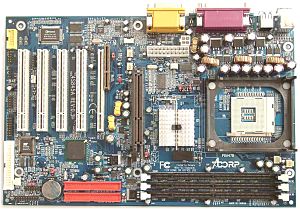 The layout is quite convenient except positions of auido-ins and a clamp on the AGP slot (it is almost impossible to unfasten it if a video card is inserted). Among its advantages is a SmartPanel (v.I & II) support which provides wider possibilities than the Asus iPanel. The first PCI slot is twice narrower, like the CNR which is next to it. There are 12 capacitors: 4 of 1500uF and 8 of 2200uF. The switches provided are meant for clearing the CMOS, activation of the AC'97 codec, changing the FSB speed - 100 or 133 MHz and for adjusting the AGP bus - 1.5, 1.6, 1.65V. The BIOS is based on the v6.00PG from AWARD. Here you can adjust memory timings, modes of the AGP bus, change the FSB frequency - 100,103, 105, 107, 109, 111, 114, 117, 120, 127, 130, 133 MHz, change the Vcore (-0.1V - +0.275V, in 0.025V steps), modify the FSB/memory/PCI bus frequencies etc. In closing I should add that the board much improves the impression of the company. Epox 4B2AE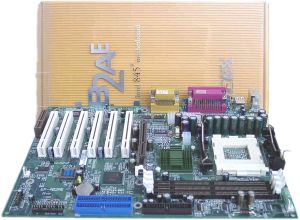 The 4B2A and the 4B2AE are very similar and differ mainly in the socket. EPoX takes this board very seriously. It has meaningly designed the package in the form of a plastic bag, like that of the 8KTA3+ model. Wide functional possibilities and high quality of the boards were always the company's pride. Unfortunately, two latest boards lack for IDE Raid and for a device displaying how the POST procedure passes. The board comes with a user's manual, ATA66/100, ATA33 and FDD cables and a bracket with two additional USB ports. Besides, there is a CD with such programs as Norton Ghost 6.03, PCCillin 2000, Boostek (a utility for a CPU overclocking from the Windows) and several system monitoring utilities. 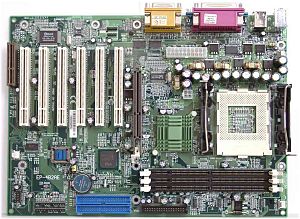 There are several drawbacks in the layout. Power supply connectors and audio-ins are not in the best position, and memory slots will be hard to reach with a video card installed into an AGP slot. But the stability of the board is as always super: there are 3 3300uF and 10 2200uF capacitors. Besides, there are several switches which will help you to clear the CMOS, to start up the system with the help of a keyboard etc. The BIOS based on the v6.00 from Award contains a lot of settings for memory modes. You can also manually distribute interrupts among PCI slots. Overclockers will be glad to see a possibility to change a FSB frequency in 1 MHz steps, Vcore in 0.025V steps, voltage of the AGP bus in 0.1V steps and of the memory in 0.1V steps as well. Besides, we can manually change a correlation of FSB, memory and PCI bus frequencies. Well, this board seems to have the best overclocking potential. Let's wait for the test results and see whether the performance is high as well. In closing I should add that a new BIOS version has lately appeared for these boards, and we tested this board with it. Asus P4B-LX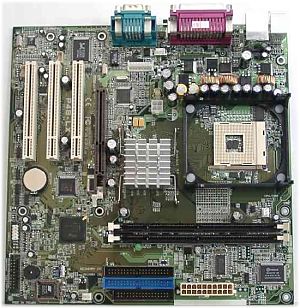 The board features a great deal of integrated functions, and the most interesting is that all this is housed in a mATX board. The board we tested is a preproduction sample, despite its version 1.04. The company spent a lot of time to eliminate all possible bugs. And as a result, everything worked flawlessly in our tests. The board comes only with a disc with drivers. It has a new shell for installation of its programs and drivers. There are such utilities as Winbond Voice Edit (for recording wav-files in EEPROM for realization of the POST Reporter technology (it notifies about booting problems), Logo (for creation of different screensavers), AsusUpdate and AsusHotkey. Of course, there is also a utility for monitoring fan speeds and temperatures - Asus PCProbe, and freeware programs such as Adobe Acrobat Reader, PC-Cillin 2000 v. 7.0 from Trend Micro, Power Player SE 5.0, VideoLive Mail 4.0 from CyberLink and 3Deep for adjusting color balance. The board incorporates a network controller, a IEEE1394 (FireWire) bus controller and the most advanced AC'97 codec from Avance Logic which allows connecting other devices in the digital mode - on the P4B board there was a bracket for the rear computer panel with a TosLink optical-out. Here the engineers soldered this output right to the board. On the whole, the rear panel looks unusual: the FireWire and optical TosLink connectors have replaced serial ports's ones, and the GamePort connector is replaced with a single serial port.  The GamePort is absent, and I understand why. There are not many modern wheels and joysticks with such connectors, they are mainly connected via a USB bus. The layout is quite convenient for the mATX format. Unfortunately, a connector for a power button, LEDs etc. was redesigned, though it looks the same. The stable core power supply is maintained by 11 capacitors - 8 of 1500uF and 3 of 2500uF. There is only one switch - for clearing the CMOS and several unsoldered ones. The BIOS is based on the v. Medallion from Award and contains a heap of various settings. Here you can adjust modes of memory and an AGP bus. You can also change a FSB frequency (100, 103, 105, 107, 109, 111, 114, 117, 120, 127, 130 and 133MHz), a CPU multiplier, a correlation of the memory and FSB frequencies (1:1 or 3:4), manually distribute interrupts among PCI slots etc. On the whole the board looks great, but I wonder who it is meant for? A home user? Then why it is equipped with a FireWire controller (there are not much nonprofessional devices with such an interface and they cost a fortune). For a video editing station? But the board is of the mATX format... Zida A845SD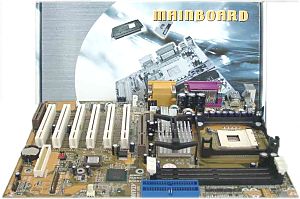 Earlier Tomato boards (Zida is a trade mark) had quite a lot of problems with quality. Unfortunately, we hadn't enough time to conduct long-run tests for fault-tolerance, but during our usual tests we noticed no such problems. In an ordinary box we have found a user's manual, ATA66/100 and FDD cables and a CD with drivers. It is interesting that it lacks for a traditional installer of the required software. Apart from drivers it contains short descriptions of mainboards from this company, utilities for system monitoring and Norton Antivirus 2001. 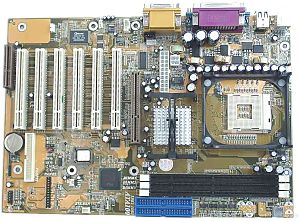 The design is rather ordinary. One of its peculiarities is fastening of a heatsink to a MCH from FoxConn. Access to FDD and power supply connectors and audio-ins can be quite difficult. There are 6 soldered holes behind the USB connectors. Switches can help you clear CMOS contents and switch an output of system signals from a speaker to the integrated audio codec. The BIOS is based on the Award's version and suggests adjusting memory timings and a CPU multiplier. Besides, you can turn on/off an integrated AC'97 codec, IDE channels etc. Well, on the one hand, the board is competitive as it showed a good speed, but as far as I remember, earlier this company produced a lot of defective products. Gigabyte 8IDXH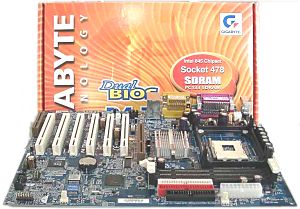 The 8IDXH from Gigabyte is a very similar to the 8IDX: their PCBs are identical, but the previous one had several unsoldered chips and connectors, there they are present. We have received a pre-production sample. The design of the package has changed. The board is traditionally based on the blue textolite. Inside the box you can find an ATA66/100 and FDD cables, a bracket with two additional USB ports, a poster with short installation instructions, a bracket for the rear computer panel, a user's manual and a CD with drivers and utilities (for example, for CPU overclocking from the Windows, for system monitoring, Norton Antivirus 2001, Norton Personal Firewall 2001, Adobe Acrobat Reader 4.05 and ITE SmartCard Editor). 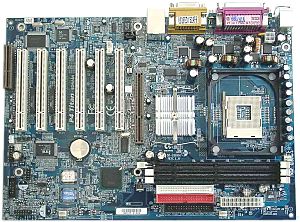 The board acquired chips for the Realtek 8100L network controller, an audio controller from Creative and the second BIOS chip. The DualBIOS technology which is now present requires two EEPROM chips. Besides there is a SmartCard reader connector, a connector for audio-outs on the front panel. To ensure a stable operation of the board the developers have equipped it with 3 3300uF, 3 1500 and 9 510uF capacitors. There is only one switch which allows turning on the computer with the help of USB and PS/2 keyboards and mice. The BIOS is based on v6.00 from Award. A possibility to choose a language is a distinguishing feature of this board (English, Japanese, French, Spanish, German and Chinese). Apart from manual distribution of interrupts and adjustment of memory timings there is a possibility to change a FSB frequency in 1MHz steps, Vcore (1.050-1.825V, in 0.025V steps), memory voltage (3.3-3.6V, in 0.1V steps) and AGP bus one (1.5-1.8V, in 0.1V steps). MSI 845 Pro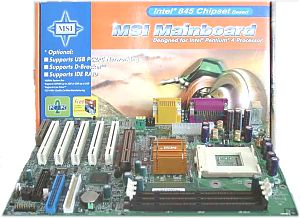 It is one of a few boards based on the system logic set with a Socket-423. On the one hand, processors with such a socket are cheaper than the models with a larger number of outputs, but such a CPU has no future, I think. Even today there are not many such boards, and when Intel's chipset with a DDR SDRAM support and VIA P4X266 boards appear, their share will be obviously vanishing. In a typical box we have found also an installation manual, HDD and FDD cables and a CD with drivers. The latter houses drivers for motherboards and video cards from MSI, Adobe Acrobat Reader, AMI and Award utilities for working with the Suspend-To-Disk function, WinFlash from Award for updating of the BIOS right from Windows, proprietary programs such as LiveBIOS and Fuzzy Logic 3, a PC Alert for monitoring temperatures and fan speeds, GoodMem for deleting unnecessary programs from the memory, MediaRing Talk, X-Setup, PCCillin 2000, 3Deep for adjusting a color balance and VNC (for a remote computer access). 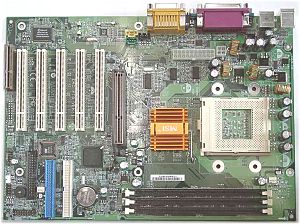 The board itself is of high quality, but the layout has some imperfections: IDE and FDD connectors are placed behind PCI ones. Power supply connectors are located between the rear panel and a socket. There are 7 capacitors of 2200uF and 3 ones of 1500uF. A switch is only one: for clearing the CMOS. The BIOS based on the AMI BIOS. Here you can change memory timings, AGP bus modes, a FSB frequency from 100 to 150 MHz in 1 MHz steps, Vcore and memory voltage. Unfortunately, you can't manually distribute interrupts among PCI slots - all other settings are standard. MSI 845 Pro2 This board is quite unique - in the florid box we have found the following accessories: a user's manual in English, a D-Bracket (a bracket with 2 USB ports and 4 LEDs for realization of the D-Led technology), a SmartKey with an extender, HDD and FDD cables and a CD. The latter contains drivers for motherboards and video cards from MSI, .pdf descriptions of these boards, Adobe Acrobat Reader, AMI and Award utilities for working with the Suspend-To-Disk function, WinFlash from Award for updating of the BIOS right from Windows, proprietary programs such as LiveBIOS and Fuzzy Logic 3, a PC Alert for monitoring temperatures and fan speeds, GoodMem for deleting unnecessary programs from the memory, MediaRing Talk, X-Setup, PCCillin 2000, 3Deep for adjusting a color balance and VNC (for a remote computer access). 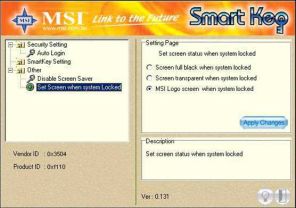 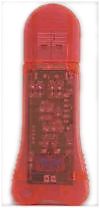 Let me dwell on the SmartKey technology. Without a special device being inserted into a USB port of your computer you will fail to start up it. Earlier it was realized in operating systems, and this key is supported in the BIOS. 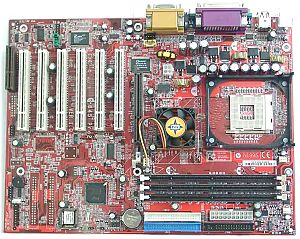 The attention is first attracted by an unsoldered IDE Raid which will be based on the Promise's chip and will appear on boards with "R" suffix - 845 Pro2-R. The C-Media audio chip allows connecting a 5.1 audio system. The layout features some drawbacks: audio-ins are placed in front of PCI connectors. There are 10 LowESR capacitors of 2200uF. Besides, there are two switches: to clear the CMOS, and to enable a possibility of recording into a BIOS boot block. The BIOS based on v.6.00 īT Award. Here you can change memory settings, AGP bus modes, a FSB frequency in 1 MHz steps, core, memory buses and AGP voltages. Unfortunately, you can't manually distribute interrupts among PCI slots. Intel D845WN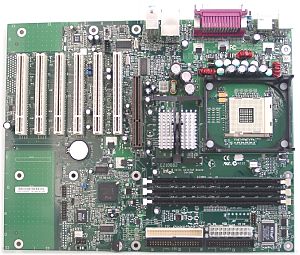 This board follows the one we described earlier: the part as you can see carries nothing but 3 PCI slots - all the components of both boards are positioned equally. Here is an absolutely new unification approach - earlier they based several versions of a board on one PCB, and now a mATX board is equipped with several PCI slots. The development time is now much shorter, but the textolite consumption is larger. This board is just a pre-production sample, that is why it is supplied only with ATA100 and ATA33 cables, an FDD one and a CD. The latter comes with drivers, a user's manual in .pdf, system monitoring utilities and some freeware programs such as Adobe Acrobat Reader, NTI CD-Maker 2000, Norton Internet Security 2001 (which includes Norton Antivirus, Norton Firewall and Norton SystemWorks) and Real Player 8. It carries 6 PCI slots and has an unsoldered place for a CNR slot. The quality of the board is high. It features an AGP Retention Mechanism to prevent wrong installation or falling out of a video card. It is not clear, though, why the second serial port is located right on the board. The layout is not very convenient: audio-ins are located in front of PCI slots. It has only one switch for BIOS recovery. You can also enter the BIOS menu and change a CPU multiplier and delete passwords. But there are also unsoldered switches to change Vcore and a FSB frequency. The BIOS based on the Phoenix BIOS offers few possibilities in changing settings. This board will be an excellent choice for those who don't like dealing with board's insides and wants only a stable product. Abit BL7 Some time ago we already studied the Abit BL7-Raid board. The only difference between these two models is in a IDE Raid controller. This production sample was packed in a new stylish box. Inside there are such accessories as a user's manual, ATA66/100 and FDD cables, a bracket with a Game-port, a bracket for the rear computer panel, a diskette with drivers for the IDE Raid and a CD with board's drivers. The CD contains a standard set of Abit's programs: a DVD player - WinDVD, Hardware Doctor, Adobe Acrobat Reader and Buzzsoft's programs - SoftCardManager, SoftCopier, SoftPostCard, SoftBulkEmail and a utility for a low-level formatting of hard discs from Award. 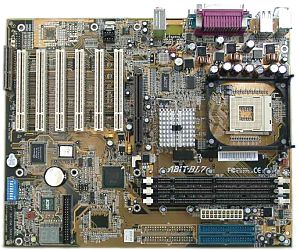 The board is quite convenient. The only disadvantage is a position of audio-ins. The board carries the Abit Engineered technology. Therefore, it has two 7-segment LEDs (so that we know how loading proceeds), power and reset buttons onboard and overclocking stripes. But the latter are, for some reason, absent. Besides, there are 5 3300uF, 2 1800uF and 4 1200uF capacitors to make the board more stable in an overclocking mode. There is also an unsoldered place for a chip and tracks coming from it to unsoldered connectors with USB_AB1 and USB_CD1 writings. The space for the IDE Raid is also provided. The switches will help you change processor modes, clear the CMOS etc. The BIOS is based on the v6.00PG from Award and features the SoftMenu technology to overclock the processor. Here you can change a memory frequency in 1 MHz steps (from 100 to 250MHz), change a FSB speed, change a CPU multiplier and Vcore. You can also alter a correlation of FSB, PCI and memory frequencies. Besides, you may adjust the AGP bus and distribute interrupts among PCI slots. Such a high overclocking potential of the board doesn't prevent it from working stably at rated and higher frequencies. Chaintech 9BJA & 9BIA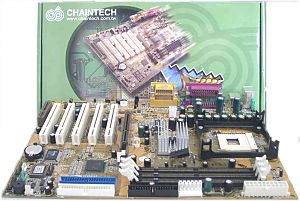 Chaintech 9BJA Both boards are already available on the market. In ordinary boxes we have found these two models based on yellow textolite, a user's manual in English, a sticker for the inner side of a system block with a description of key switches and functional connectors, ATA66/100 and FDD cables and a CD. The latter offers only drivers for Chaintech boards. 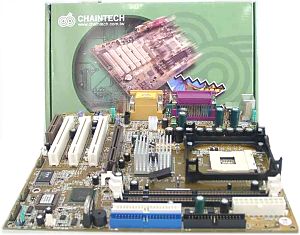 Chaintech 9BIA. The full-sized board incorporates an audio controller from C-Media which allows connecting a 6-piece acoustic system. It also has a SmartCard reader. The other board which is of the MicroATX format houses an AC'97 codec from Avance Logic (Realtek). 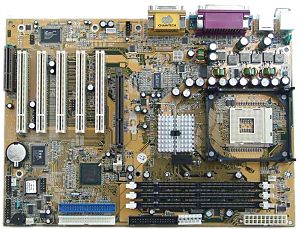 Chaintech 9BJA Like any other board these ones failed to avoid some drawbacks. This time it is a connector of external USB ports which is located between PCI slots and audio-ins which are put in front of PCI. It is interesting that the first board lacks for an SPDIF connector. A stable operation is maintained by 16 capacitors on the larger board (12 of 1500uF and 4 of 1200uF) and by 14 ones on the smaller one (10 of 1500 and 4 of 1200uF). Switches are traditionally designed for clearing the CMOS and for a possibility to turn on a computer with devices connected to PS/2 and USB ports. 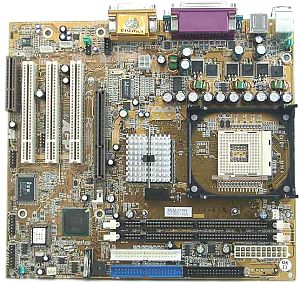 Chaintech 9BIA. The BIOS based on the Award Modular BIOS v. 6.00PG offers plenty of settings for memory timings, an AGP bus and a manual distribution of interrupts among PCI slots. Moreover, you can change a FSB frequency and a Vcore. Besides, the Instant HDD Recovery will help you to recover saved data before an OS is loaded in case of problems with your hard disc. The general impression is that these are good middle-level boards with some intriguing functions. PCPartner 845AS4-235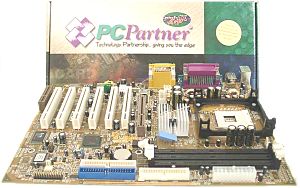 The first thing that catches your eye is a long name. However, the company produces a wide range of boards, and they developed 6 models on only this one chipset. A cardboard box contains also a scanty user manual, ATA66/100 and FDD cables and a CD which offers us drivers for the board and PCCillin 2000. 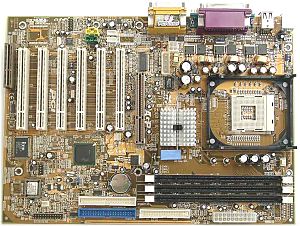 Disadvantages are undoubtedly present: they are inconveniently placed audio-ins, too close IDE, FDD connectors and memory slots. At the same time, for power supply units of the old format there is a 12V connector where we can insert a plug usually used for hard discs etc. There is also an unsoldered chip of a network controller. A stable operation is provided by 5 capacitors of 3300 and 2 ones of 2200uF. The switches which are 3 on the board can help you clear the CMOS, turn on/off an audio controller and startup a system with a keyboard. The BIOS is based on the v6.00PG from Award. This board can't be proud of the largest number of memory settings. But a CPU overclocking is a hard task as there is only a possibility to change its multiplier locked in the processor. In closing I'd like to note that the board passed all the tests flawlessly despite being so cheap. PerformanceTest system:
Software:
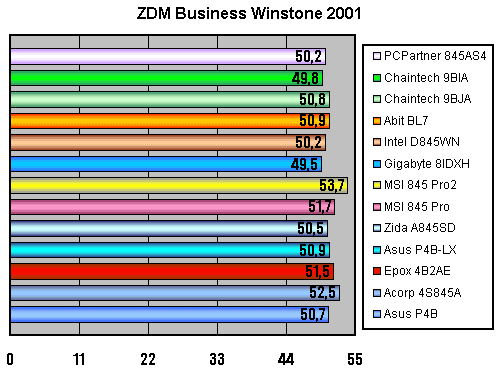 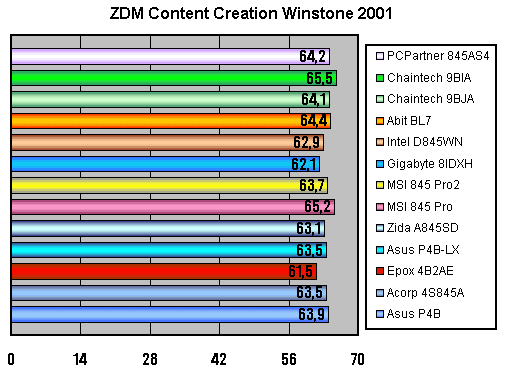 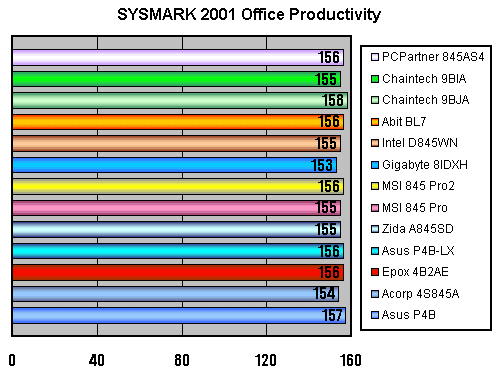 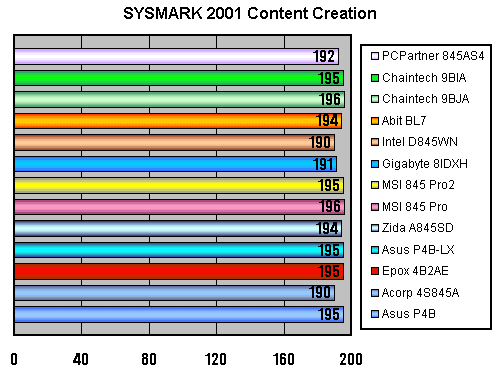 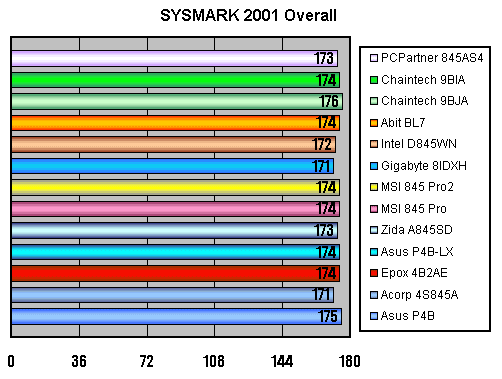 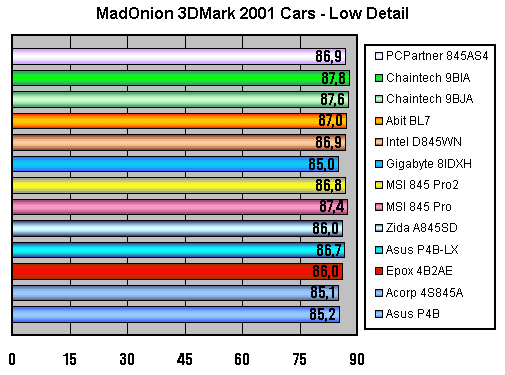  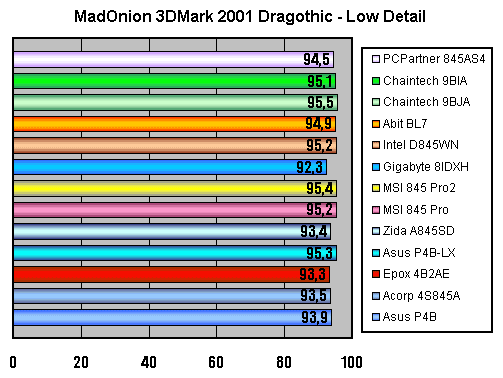 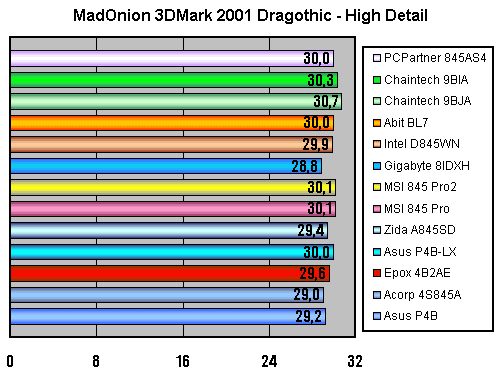 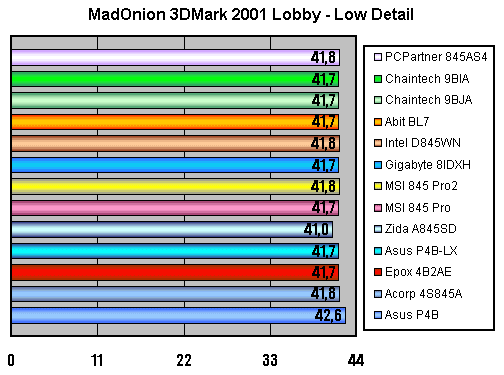 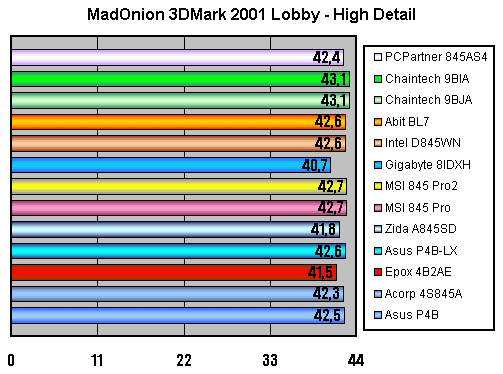 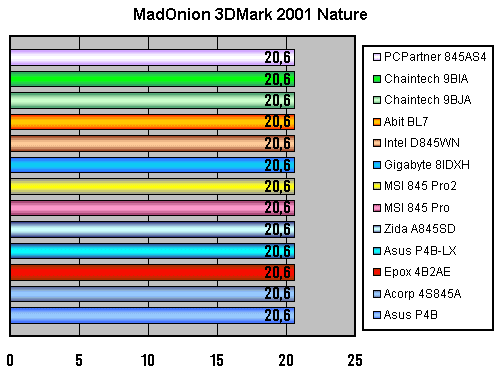 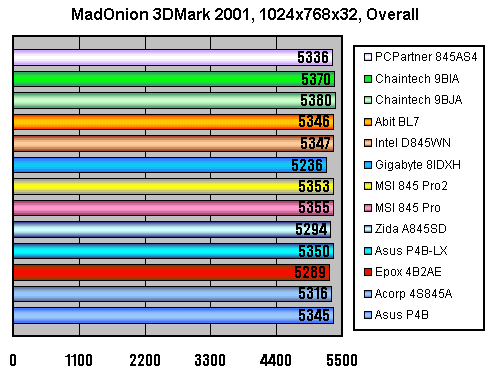 .png) .png) 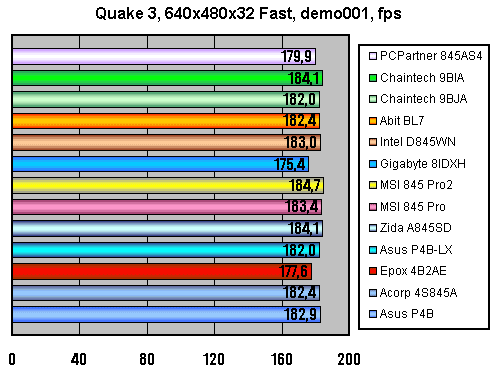  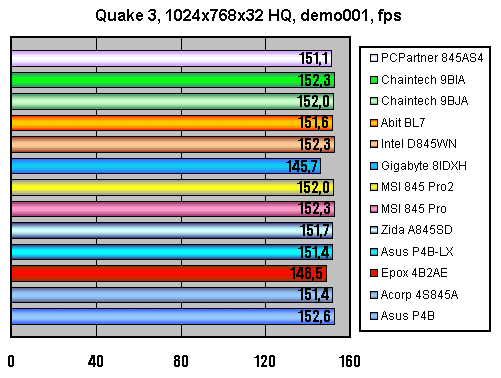  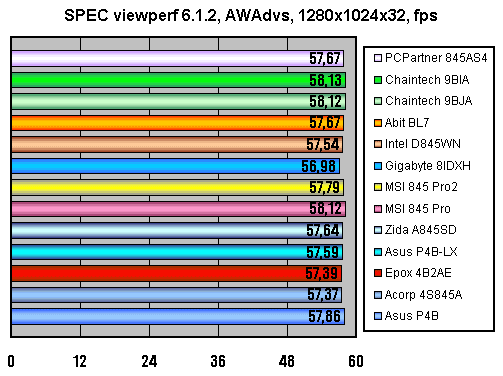 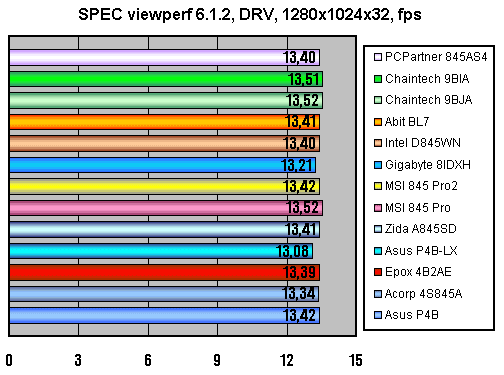 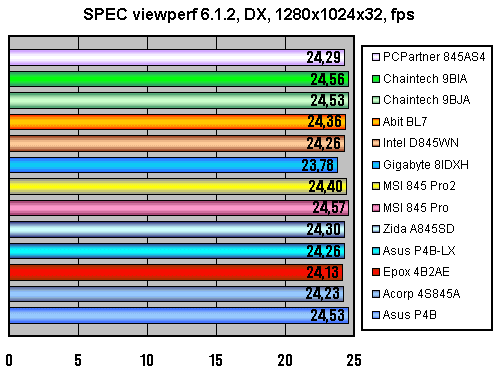 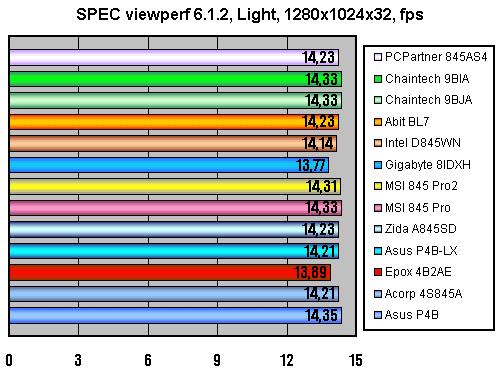 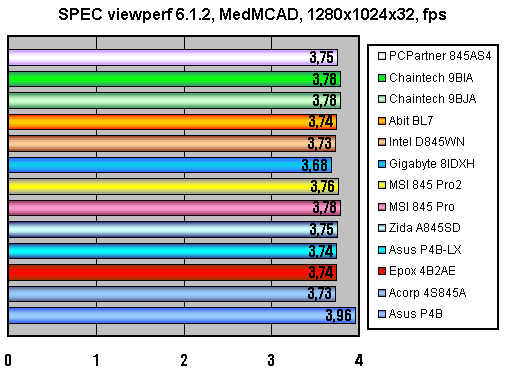 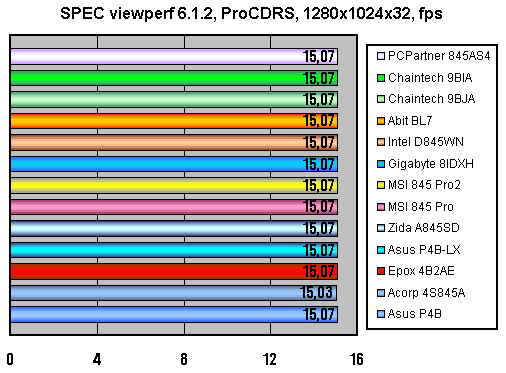 As far as I can judge, there are no vivid leaders. But such close results allow me to draw two conclusions - good and bad. Good: it is obvious that the chipset was created and distributed among developers a long time ago - by the beginning of the sales almost all manufacturers had a board with an excellent performance level. Just compare with the i850 boards when they were released. Bad: it is obvious that the performance peak which could be reached by a BIOS optimization has already achieved. That is why now the performance can be lifted only via new chipset revisions, or, for example, the Northwood processor with a large L2 cache. But it concerns only boards for the Socket-478. ConclusionSome our readers consider that the i850 based boards are produced only for Socket-423, and i845 ones - only for Socket-478. It is wrong. For example, the MSI 845 Pro or ABIT BW7 which are based on the i845 are meant for the Socket-423, and the ASUS P4T-E is designed for the Socket-478. Exactly this solution on the i845 which combines a support of a cheaper processor and memory type or on the i850 providing the highest performance with an eye to future Northwood are the most attractive for today. And in one, two or three months the Socket-478 will finally replace the Socket-423, but who knows, maybe by that time the market will be glutted with VIA P4X266 boards or, undecided, you will be waiting for the i845-D... Anyway, if you have decided to buy a board on the
i845 for the Socket-478 or for the Socket-423, you have a wide choice.
All boards perform equally and are quite reliable. It means that
a determining factor will be functionality, overclockability, personal
preferences and of course, a price.
Write a comment below. No registration needed!
|
Platform · Video · Multimedia · Mobile · Other || About us & Privacy policy · Twitter · Facebook Copyright © Byrds Research & Publishing, Ltd., 1997–2011. All rights reserved. |